1. Pronotum with paramedian grooves incomplete anteriorly or entirely absent (Figure 1)...................................21'. Pronotum with paramedian grooves complete, extended to anterior margin of pronotum (Figure 2)......................5 Click on an image to view larger version & data in a new window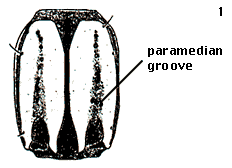
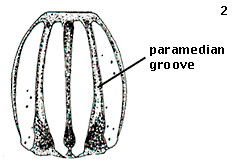
2(1). Middle and hind tibiae each with one apical spur, paramedian grooves almost complete but evanescent anteriorly, not differentiated into distinct basal impressions and discal strioles (Figure 3)..............................Plesioglymmius2'. Middle and hind tibiae each with two apical spurs; pronotum either with paramedian groove represented by distinct basal impression preceded by distinct discal strioles, or else paramedian grooves entirely absent (Figure 4).................3 Click on an image to view larger version & data in a new window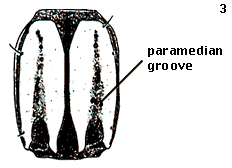
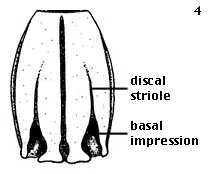
3(2). Eye with distinct ommatidia, either fully developed or else slightly reduced but not protruding; basal scarp of elytron simple, transverse (Figure 5)..........................Yamatosa3'. Eye minute, ocelliform, protruded, without visible ommatidia; basal scarp of elytron not transverse. ...........4 Click on an image to view larger version & data in a new window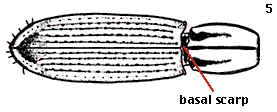
4(3). Basal scarp of elytron oblique, straight, limiting triangular depression around scutellum; basal impression not preceded by discal striole; frontal grooves incomplete anteriorly (Figure 6)..................................Shyrodes4'. Basal scarp bisinuate anteriorly, with prominent angle opposite bases of striae IV, V; basal impressions absent; frontal grooves complete anteriorly (Figure 7)..........Srimara Click on an image to view larger version & data in a new window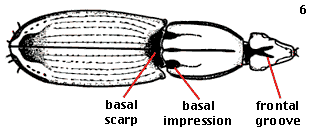
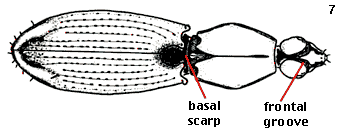
5(1). Hind tibia with one spur. .........................Omoglymmius 5'. Hind tibia with two tibial spurs. ...........................6
6(5). Dorsal surface shining, largely impunctate; angular seta of pronotum absent; hind tibia of male straight. ........Arrowina 6'. Dorsal surface opaque, very heavily punctate; angular seta present; hind tibia of male bent at middle of length. ......................................................Xhosores
Figures 5, 6, 7 modified from:
Bell, R. T. and J. R. Bell. 1978. Rhysodini of the World part I. A new classification of the tribe, and a synopsis of Omoglymmius subgenus Nitiglymmius, new subgenus (Coleoptera: Carabidae or Rhysodidae). Quaestiones Entomologicae 14: 43-88.
Copyright © 1978, R. T. Bell and J. R. Bell.
Figures 1 and 3 modified from:
Bell, R. T. and J. R. Bell. 1979. Rhysodini of the World part II. Revisions of the smaller genera (Coleoptera: Carabidae or Rhysodidae). Quaestiones Entomologicae 15: 377-446.
Copyright © 1979, R. T. Bell and J. R. Bell.
Figures 2 and 4 modified from:
Bell, R. T. and J. R. Bell. 1982. Rhysodini of the World Part III. Revision of Omoglymmius Ganglbauer (Coleoptera: Carabidae or Rhysodidae) and substitutions for preoccupied generic names. Quaestiones Entomologicae 18: 127-259.
Copyright © 1982, R. T. Bell and J. R. Bell.




 Go to quick links
Go to quick search
Go to navigation for this section of the ToL site
Go to detailed links for the ToL site
Go to quick links
Go to quick search
Go to navigation for this section of the ToL site
Go to detailed links for the ToL site